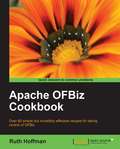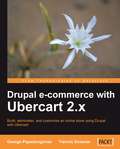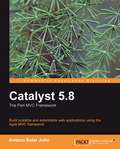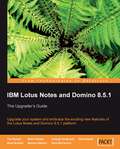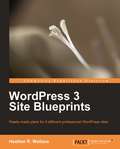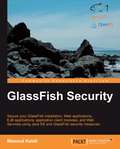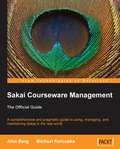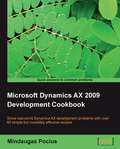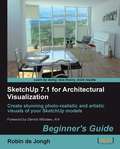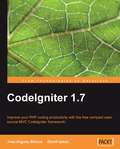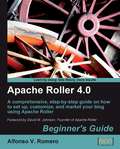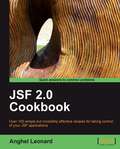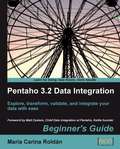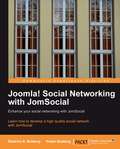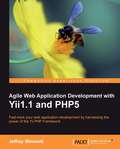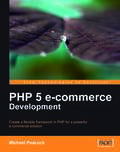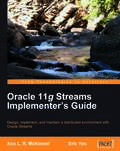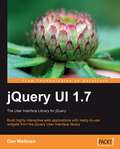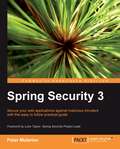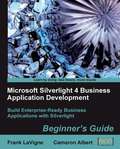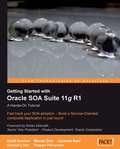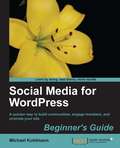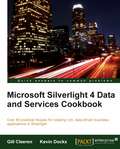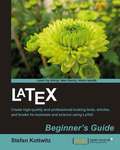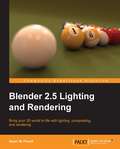- Table View
- List View
Apache OfBiz Cookbook
by Ruth HoffmanThe best way to experience OFBiz is to dive right in and start "kicking the tires". No matter if you are an end user exploring the out-of-the-box e-commerce web store or a software developer getting ready to build a new application, you will find, eventually, that you perform the same tasks over and over again. This book is designed as a reference to guide you though those oft-encountered OFBiz tasks. It is a collection of recipes, not necessarily in any particular order of importance, that address and give answers to many of the real-world questions asked about how to do things with OFBiz. If you are an OFBiz user who has some familiarity with enterprise software systems, and perhaps more importantly, Internet and Web exposure, you will be able to glean useful information from this book. You will need only basic knowledge of modern browser behavior (for example: how to click a mouse button) to follow some recipes, while others assume a passing familiarity with a text-editor and XML documents. If you are a software developer looking for Java and/or Groovy examples, this book also includes a chapter on Java software development.
Drupal E-commerce with Ubercart 2.x
by Yiannis Doxaras George PapadongonasThis book will take you through the basics, like Drupal and Ubercart installation and common settings, and as we proceed through the chapters, we'll implement more advanced techniques. Whether you know Drupal or not, this book will be your guide to creating a powerful e-commerce web site. If you are a business owner wanting to create an eCommerce website for your company or to upgrade a company eShop to be easier to maintain and have advanced e-shopping capabilities, then this book is meant for you. You don't need any programming experience to use this book.
Catalyst 5.8: the Perl MVC Framework
by Antano Solar JohnThe book is written in an exploratory style: try something and then understand how it works. It will guide you through the features of Catalyst using real-world examples and systematic code snippets. If you are a Perl Developer and want to strengthen your skill by understanding Web Application development using MVC principles, then this book is for you.
IBM Lotus Notes and Domino 8.5.1
by Bennie GibsonThis book walks through the new features of the Lotus Notes/Domino 8.5.1 suite and documents technical features in a descriptive way, with examples and useful screenshots. The book also discusses likely problems you might face while upgrading, and shows how to get the most out of the exciting new features. This book is for Lotus Notes power users, administrators, and developers working with any version of Lotus Notes/Domino, who want to upgrade to Lotus Notes/Domino 8.5.1. Additionally, it can be leveraged by management to gain a high-level understanding of the new features and capabilities offered within the products.
WordPress 3 Site Blueprints
by Heather R. WallaceFollow along as we work together to build a variety of sites--all using WordPress. While this book is not designed for beginners, those with even an intermediate knowledge of WordPress will be able to get these sites up and running in no time. Also, since each chapter is devoted to the design of a different site, there is no need to read the book in any particular order. Instead, you can pick and choose the blueprints that are of most interest to you and dive right in. If you are a self-learner or a WordPress consultant who, instead of being content with using WordPress out-of-the-box, is interested in exploring all that this open source software has to offer, then this book is for you. The clear instructions provided in each chapter will guide you through the process of creating a varied collection of WordPress sites for either yourself or a client. While some experience with WordPress is required to get the most from this book, if you can install themes and plugins, you should be able to follow these easy-to-understand WordPress blueprints. Some knowledge of CSS and HTML will be beneficial, but experience with PHP is not required.
GlassFish Security
by Masoud KalaliSecurity is driven by requirement and design and we implement security on the basis of the requirements provided by analysts. In this book, we take a programmatic approach to understand Java EE and GlassFish security. You will find plenty of code samples in this book. It is easy to secure your application when you have a demonstration of a complete and working application explained in the book, isn't it? Each chapter starts with the importance and relevance of the topic by introducing some Java EE applications requirement, which will encourage you to read it further. This book is for application designers, developers and administrators who work with GlassFish and are keen to understand Java EE and GlassFish security. To take full advantage of this book, you need to be familiar with Java EE and GlassFish application servers. You will love this book if you are looking for a book that covers Java EE security and using GlassFish features to create secure Java EE applications, or to secure the GlassFish installation and operating environment and using OpenSSO.
Sakai Courseware Management: The Official Guide
by Michael Korcuska Alan Mark BergThe book takes a step-by-step, practical approach and is filled with examples and illustrations. This book is written for a wide audience that includes teachers, system administrators, and first time developers. It will also appeal to the Sakai open source community, potential community members, and education's decision makers.
Microsoft Dynamics AX 2009 Development Cookbook
by Mindaugas PociusThis book contains a list of useful Dynamics AX modifications – recipes – along with all required code and in-depth explanations. Most of the recipes are presented using real-world examples in a variety of Dynamics AX modules. The step-by-step instructions along with many useful screenshots make learning easier. This book is for Dynamics AX developers, and is primarily focused on delivering time-proven application modifications. Although new X++ developers could use this book along with their beginner guides, this book is focused more on people who are willing to raise their programming skills above the beginner level, and at the same time learn the functional aspects of Dynamics AX. So, some Dynamics AX coding experience is expected.
SketchUp 7.1 for Architectural Visualization: Beginner's Guide
by Robin De JonghWritten with a fast-paced but friendly and engaging approach, this Packt Beginner's Guide is designed to be placed alongside the computer as your guide and mentor. Step-by-step tutorials are bolstered by explanations of the reasoning behind what you are doing. You will quickly pick up the necessary skills, tips, and tricks for creating successful SketchUp visualizations with practical examples that help you to learn by experiment and play. This book is suitable for all levels of Sketchup users, from amateurs right through to architectural technicians, professional architects, and designers who want to take their 3D designs to the next level of presentation. SketchUp for Architectural Visualization is also particularly suitable as a companion to any architectural design or multimedia course, and is accessible to anyone who has learned the basics of SketchUp.
CodeIgniter 1.7
by David Upton Jose Argudo BlancoThis book takes a step-by-step approach, presenting the main features of CodeIgniter in a systematic way and explaining them clearly. It is packed with examples, ideas, and screenshots to help you master this great framework. The code examples are very practical so you can even use them in your own projects. By following this book, you can use CodeIgniter in the best possible way and maximize your learning. This book is for developers who are new to CodeIgniter. Basic skills in PHP and MySQL are required, but only rudimentary object-oriented knowledge is needed. If you're looking for a better way to develop PHP applications, or want to find out more about the CodeIgniter framework as a viable option for one of your own projects, this book will help you.
Apache Roller 4.0 – Beginner's Guide
by Alfonso RomeroThis beginner's guide is packed with information, tips, and tricks, based on the author's extensive experience with Apache Roller. In next to no time, you will be able to build and deploy your own blog. The clear and concise hands-on exercises will teach you everything you need to know to install, configure, and use Apache Roller, along with the open source software required to run it. The book includes plenty of illustrations to guide you through all the detailed exercises and tutorials, so you can get the most out of every chapter. If you are interested in establishing a blog, using Apache Roller and popular web applications to write attractive posts and promote your blog on all the major social bookmarking services, this book is for you. No previous experience on Tomcat, MySQL, the Apache Web Server, or Linux is required.
JSF 2.0 Cookbook
by Anghel LeonardThe JSF 2.0 Cookbook contains step-by-step instructions for JSF users to build desktop-style interfaces in their own web applications. The book is designed so that you can refer to it chapter by chapter, or you can look at the list of recipes and read them in no particular order. This book is for two types of audience: Newcomers who know the basics of JSF but are yet to develop real JSF applications., JSF developers who have previous experience but are lacking best practices and a standard way of implementing functionality
Pentaho 3.2 Data Integration: Beginner's Guide
by Maria Carina RoldanAs part of Packt's Beginner's Guide, this book focuses on teaching by example. The book walks you through every aspect of PDI, giving step-by-step instructions in a friendly style, allowing you to learn in front of your computer, playing with the tool. The extensive use of drawings and screenshots make the process of learning PDI easy. Throughout the book numerous tips and helpful hints are provided that you will not find anywhere else. The book provides short, practical examples and also builds from scratch a small datamart intended to reinforce the learned concepts and to teach you the basics of data warehousing. This book is for software developers, database administrators, IT students, and everyone involved or interested in developing ETL solutions, or, more generally, doing any kind of data manipulation. If you have never used PDI before, this will be a perfect book to start with. You will find this book is a good starting point if you are a database administrator, data warehouse designer, architect, or any person who is responsible for data warehouse projects and need to load data into them. You don't need to have any prior data warehouse or database experience to read this book. Fundamental database and data warehouse technical terms and concepts are explained in easy-to-understand language.
Joomla! Social Networking with JomSocial
by Beatrice A. Boateng Kwasi BoatengA practical guide, this book provides step-by-step instructions for building your social networking system, showcasing real-world examples throughout. This book is for individuals or institutions desiring to develop a social networking system using the Joomla! content management system. It is suitable for both the novice and the advanced Joomla! user. There is no need for scripting or programming knowledge. All that is required is enthusiasm and the determination to implement a project.
Agile Web Application Development with Yii1.1 and PHP5
by Jeffrey WinesettThis is a step-by-step tutorial for developing web applications using Yii. This book follows the test-first, incremental, and iterative approach to software development while developing a project task management application called "TrackStar". If you are a PHP programmer with knowledge of object oriented programming and want to rapidly develop modern, sophisticated web applications, then this book is for you. No prior knowledge of Yii is required to read this book.
PHP 5 e-commerce Development
by Michael PeacockThis is a fast-paced tutorial focusing on creating a framework and using it to build an online store through an ongoing case study. Later chapters include examples to illustrate how easily the framework can be adapted for different situations. The framework and code are enhanced and built upon with each chapter, adding more and more functionality. If you are a web developer, or anyone looking to increase your understanding of e-commerce site development, this book is for you. Primarily aimed at PHP developers, it is suitable for any web developer interested in enhancing their e-commerce knowledge, or developers looking to move towards PHP. Intermediate knowledge of PHP development and object-oriented programming is assumed, and basic knowledge of e-commerce principles will be of benefit too.
Oracle 11g Streams Implementer's Guide
by Ann L. Mckinnell Eric YenThis book has a tutorial approach that provides both theoretical explanations and practical step-by-step examples using familiar Oracle demo schemas. Step-by-step examples include use of both Enterprise Manager and the SQLPLUS command-line interface. The authors have combined their experiences of working with customers in Oracle Support, Oracle training and education, and Oracle consulting, to identify the most common areas of confusion and misinterpretation experienced by Oracle Streams users. This book highlights these areas and focuses on bringing clarity and understanding to the reader. This book is for users who have implemented, or are about to implement, a distributed database environment using Oracle Streams replication. The reader is expected to have an intermediate understanding of Oracle database technology. This book is mainly intended for use by: Oracle Database Administrators responsible for the implementation and maintenance of an Oracle Streamed environment, System and Database Architects responsible for the design of distributed database environments using Oracle Streams Readers with limited knowledge of basic Oracle database technology can benefit from Chapters 1 and 2, which cover Oracle Streams Components and Design Considerations.
jQuery UI 1.7: The User Interface Library for jQuery
by Dan WellmanAn example-based approach leads you step-by-step through the implementation and customization of each library component and its associated resources in turn. To emphasize the way that jQuery UI takes the difficulty out of user interface design and implementation, each chapter ends with a 'fun with' section that puts together what you've learned throughout the chapter to make a usable and fun page. In these sections you'll often get to experiment with the latest associated technologies like AJAX and JSON. This book is for front-end designers and developers who need to quickly learn how to use the jQuery UI User Interface Library. To get the most out of this book you should have a good working knowledge of HTML, CSS, and JavaScript, and will need to be comfortable using jQuery, the underlying foundation of jQuery UI.
Spring Security 3
by Peter MularienThe book starts by teaching the basic fundamentals of Spring Security 3 such as setup and configuration. Later it looks at more advanced topics showing the reader how to solve complex real world security issues. This book is for Java developers who build web projects and applications. The book assumes basic familiarity with Java, XML and the Spring Framework. Newcomers to Spring Security will still be able to utilize all aspects of this book.
Microsoft Silverlight 4 Business Application Development: Beginner’s Guide
by Cameron Albert Frank LavigneA Beginner's Guide tutorial, this book offers learning and techniques through a suite of business applications. It contains step-by-step instructions for developers who want to build rich business applications using Silverlight. The book focuses on practical examples and has a friendly approach, with the opportunity to learn by experiment and play. It uses illustrations, screenshots, and interactive experiences to understand the most complex topics related to Silverlight business application development. It is designed in such a way that you can refer to topics chapter by chapter, and read them in no particular order. If you are a .NET developer who wants to build business applications with Silverlight, then this is the book for you. No experience of programming Silverlight is required. Basic understanding of Visual Studio, C#, .Net development, XML, and Web development concepts (HTTP, Services) is required.
Getting Started With Oracle SOA Suite 11g R1 – A Hands-On Tutorial
by Demed L'Her Heidi BuelowThis fully illustrated step-by-step tutorial is based on proven training material that has been highly praised by hundreds of developers in product training courses given as part of the SOA Suite 11g rollout. You will learn how to build a services-oriented composite application project iteratively with each chapter introducing new technology components and adding a functional increment. Each chapter comes with a working solution for your reference. You can use the solution to start the tutorial at any point or to jump around to the chapters that most interest you. This clear and detailed tutorial is perfect for both new and experienced SOA developers looking for a pragmatic and hands-on approach to learning Oracle SOA Suite 11g.
Social Media for WordPress: Build Communities, Engage Members and Promote Your Site
by Michael KuhlmannFast paced, quick to read, impossible to put down, this book is a complete plan for social engagement on the web. You've heard plenty of social media success stories. You know your WordPress site inside and out, but you want help. Stop right now and pick up a copy of this book.
Microsoft Silverlight 4 Data and Services Cookbook
by Gill CleerenWritten in a cookbook style, this book offers learning and techniques through recipes. It contains step-by-step instructions for developers who want to build rich data-driven business applications using Silverlight. The book is designed in such a way that you can refer to things chapter by chapter, or read them in no particular order. If you are a .NET developer who wants to build professional data-driven applications with Sliverlight, then this book is for you. Basic experience of programming Silverlight and familiarity with accessing data using ADO.NET in normal .NET applications is required.
LaTeX Beginner's Guide
by Stefan KottwitzPacked with fully explained examples, LaTeX Beginner's Guide is a hands-on introduction quickly leading a novice user to professional-quality results. If you are about to write mathematical or scientific papers, seminar handouts, or even plan to write a thesis, then this book offers you a fast-paced and practical introduction. Particularly during studying in school and university you will benefit much, as a mathematician or physicist as well as an engineer or a humanist. Everybody with high expectations who plans to write a paper or a book will be delighted by this stable software.
Blender 2.5 Lighting and Rendering
by Aaron W. PowellEach chapter develops a different aspect of a Blender technique. The book is essentially a step-by-step tutorial, which builds up your knowledge throughout. It has practical examples such as lighting a tricycle in open space, lighting a wine bottle on a table, and lighting a room that has a lamp as well as sunlight coming in through the window. These examples will show you how to implement the different Blender techniques in your work.If you are a Blender user and you want to improve the quality of your renders, this book is for you. You need to have experience in Blender and know your way around the Blender interface. You may be a professional or freelancer or hobbyist willing to increase the quality of your portfolio and interested in adding perfection to your renders.
